May 25, 2012
This is the death certificate of Jesse F. Bruther. Jesse was the son of Caleb Bruther and Emily Burgtal and the father of Loretta Elizabeth (Bruther) Wakefield.
Jesse was December 19, 1867 and died April 10, 1950. He is buried in Old Bethel Cemetery.

Posted in Associated Families, Indiana |
Leave a Comment »
May 25, 2012
This is a photo of Lewis N. Bruther and his new wife, Grace A. Miskell. They were married on July 28, 1889 in Jefferson County, Indiana. Lewis is the brother of my great-grandfather, Jesse F. Bruther. Jesse is the father of Loretta Elizabeth (Bruther) Wakefield.
Sadly, Lewis died just 2 1/2 years after he and Grace were married.
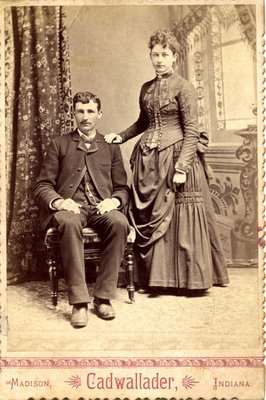
Posted in Associated Families, Indiana |
Leave a Comment »
May 25, 2012
While visiting with Ruth Ann (Bruther) Hoover in California this past February, she was kind enough to lend me this photo of her uncle, William (Will) Smythe. Will is the husband of Elsie Emily (Bruther) Smythe. Ruth Ann is the daughter of Ervin D. Bruther and Clara (Hargitt) Bruther.


Posted in Associated Families, Indiana |
Leave a Comment »
May 22, 2012
My mom has had this photo in her living room for several years and I have wanted to make a copy of it for just as long. Finally, after years of pleading, she gave up the picture so I could make a copy. The picture is of Willard Totten Wakefield, a.k.a. Bobo, likely taken when he was a teenager. The quality is not that great but it probably is one of the earliest pictures of Bobo that we have in our collection.

Posted in Indiana, My Direct Line, Wakefield |
Leave a Comment »
May 15, 2012
Soldiers from Indiana played a critical role in the War of 1812. Among the participants in the war was John Wakefield, a private from Franklin County serving under Captains Shultz and Clements.
From the Indiana Muster, Pay and Receipt Rolls, Indiana Territory Volunteers and Militia, War of 1812, we can see several payments made to John for his services to his country. John’s entries can be found in Volume 3 on pages 474, 475, 476, 477, and 478. The following image is an inverted copy of page 478 showing John Wakefield’s signature for receipt of payment for his services:

From IUPUI’s University Library, information about this War of 1812 collection:
This collection consists of Muster, pay and receipt rolls of Indiana territory volunteers or militia of the period of the War of 1812. They are in the form of four oversized bound volumes of photostats made by Leet Brothers Co. in 1926 from information in the U.S. Adjutant General’s Office. According to the following note, “The U.S. Adjutant general states that these records do not include the names of soldiers of the regular army of the U.S. and member of the U.S. Rangers who enlisted from Indiana territory. The names listed…include Justices of the Peace, administrators, administratrices, clerk of court, witnesses, widows, attorneys, substitutes, etc.”
The four physical volumes digitized here reside in the collection of the Genealogy Division, Indiana State Library. An Index was created by Genealogy Division staff and bound into Volume 1.
Posted in Indiana, Military, Wakefield |
Leave a Comment »
May 8, 2012
In the 1600s, the patriarchs of the southern branch of the Wakefields are found in various locations in and around the Chesapeake Bay area. Maryland tax records from 1678 and 1681 show Thomas Wakefield and Richard Wakefield paying tobacco-related taxes. Charles is present in both the 1678 and 1681 tax lists whereas Richard is only present in the 1681 tax list. Unfortunately, only the 1678 tax list includes the country of the person being taxed. As a result, only Thomas’s county of residence, Charles County, is known.
1678 Tax
The following information was extracted from the reference cited below. It should act as at least a partial census of Maryland for the year 1678 since all inhabitants were levied a tax of tobacco. The manner of determining the amount of the levy is unknown but appears to be based in part on the amount of land or property owned by the individual. Therefore, the relative size of the levy should give some indication of the wealth of the individual. The number appearing after each name is the levy assessed in pounds of tobacco.
The 1678 Tax List entry (Charles County):
Wakefeild, Thomas – 300
1681 Tax
The following information was extracted from the reference cited above. It should act as a partial census of Maryland for the year 1681 since all inhabitants were levied a tax of tobacco. The manner of determining the amount of the levy is unknown but appears to be based in part on the amount of land or propery owned by the individual. Therefore, the relative size of the levy should give some indication of the wealth of the individual. The number appearing after each name is the levy assessed in pounds of tobacco. It is apparent that some of the individuals in the list are being paid for services to the province.
The 1681 Tax List entries:
Wakefeild, Richd – 230
Wakefeild, Tho: – 200
Posted in Maryland, My Direct Line, Wakefield |
Leave a Comment »
May 7, 2012
As previously discussed, Jacob J. Wakefield served with the 146th Indiana Regiment during the Civil War. Although they were mustered into service late in the war, I thought it would interested to track their journey from Indianapolis to Baltimore. Below is a high-level map of their path to Baltimore:

The regiment began in Indianapolis and primarily worked guard and post duties for a short stretch of locations from Winchester, VA to Harper’s Ferry, WV, represented by the green location markers. Later the regiment was divided to work various locations in Maryland and Delaware, represented by the yellow location markers. The red marker’s indicate their final stops at the Indiana State House and Camp Carrington.
Information on the 146th as found on another researcher’s site:
According to ONE YEAR REGIMENTS OF 1865, the 146th left Indianapolis in March 11, 1865, under the command of Colonel Merit C. Welsh. It arrived in Harper’s Ferry, Virginia, on March 15. The regiment was then assigned to one of the provisional divisions of the Army of the Shenandoah. Until July 27, 1865, it was assigned post and guard duty at Charlestown, Winchester, Stevenson Station, Jordan’s Springs, and Summit Point, Virginia.
The regiment was then assigned to the Military District of Delaware with General Lockwood commanding. Companies were sent to Hick’s General Hospital, Baltimore; Havre De Grace, Dover, Wilmington and Salisbury in Delaware; and Easton, Maryland. On August 31, 1865, the regiment rejoined in Baltimore and was mustered out. The regiment was back in Indianapolis on September 8, 1865, and was welcomed with a reception held on the State House lawn. After marching to Camp Carrington, it was paid off and discharged.
From the Indiana Historical Society, information regarding Camp Carrington:
Camp Carrington was established as a Civil War camp in 1862 in Indianapolis. It was named for General Henry B. Carrington, who served as Colonel and Brigadier General in the Union Army. It was one of the largest of the twenty-four camps established during the war in the Indianapolis area, and was located between the Canal and Fall Creek near present-day 15th and Missouri Streets. When it originally opened it was known as Camp Murray. It replaced Camp Morton as the main training camp when Camp Morton was established as a POW camp. During the last year of the war practically all the Indiana regiments were organized there.
Posted in Indiana, Military, My Direct Line, Wakefield |
Leave a Comment »
May 5, 2012
It is believed that Thomas Wakefield, who migrated from England in 1635, is the founder of the southern branch of the Wakefields in the burgeoning colonies of North America. As can be seen by the images below from The Original Lists of Persons of Quality, Thomas was just 17 years old when he made the journey on the ship America. The ship departed from Gravesend on June 23, 1635, where its passengers “were seeking new opportunities and advanced social status far from the restrictive practices in England at the time.”

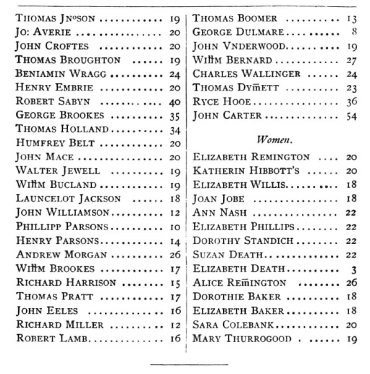
There were 86 passengers on the ship and, of which, there were 72 males and 14 females. Average age of the passengers was 22.2 years old. The youngest passenger was 3 while the oldest passenger was 54. Seventy-one, of the 86 passengers, were between the ages of 11 and 30.
Posted in Migration, My Direct Line, Wakefield |
Leave a Comment »
April 24, 2012
As mentioned in my previous post, my grandparents lived for a few years in Franklin, Indiana. Here is a picture of my Mom, Sally Jo (Wakefield) Meziere, as a young child in Franklin.
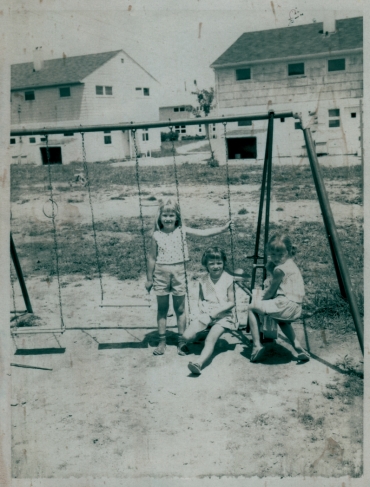
Note: My Mom is the one standing.
Posted in Indiana, My Direct Line, Wakefield |
Leave a Comment »
April 24, 2012
My grandparents, Willard Darrell Wakefield and Phyllis Ruth (Stage) Wakefield, were married in July, 1953. After they were married they lived in Franklin, Indiana until they eventually moved to New Whiteland, Indiana, the place they have called home for over 50 years. The following is their listing from 1957 Franklin directory:
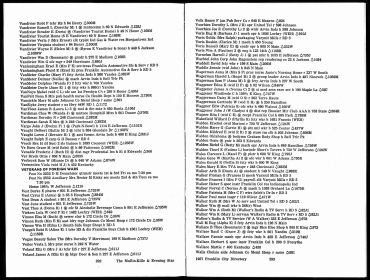
The listing shows my grandparents living at 1681 Francis Street in Franklin. It also lists my grandpa’s occupation as factory worker. Here is the location of the house:
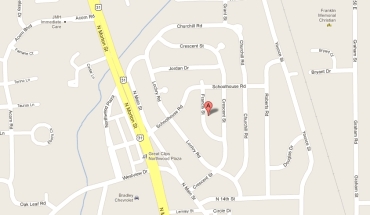
Posted in Indiana, My Direct Line, Wakefield |
1 Comment »
April 23, 2012
Here is my great-great-grandfather’s entry from the 1940 census. He is living with his oldest son, Wallie, otherwise known as Walter Craig Wakefield, and his recently deceased wife’s sister, Nina Boggs. They are living in a rented house outside the town limits of Hanover, Indiana in Hanover Township, Jefferson County.

Note: The entry after Isaac’s is Gordon Bruther and his family. Gordon is Loretta Elizabeth (Bruther) Wakefield’s first cousin.
Posted in Indiana, My Direct Line, Wakefield |
Leave a Comment »
April 23, 2012
Jacob J. Wakefield’s family in the 1860 census and the 1870 census. The 1870 census shows the widowed Susannah living with her parents, Jacob and Sarah Banta.


Posted in Indiana, My Direct Line, Wakefield |
Leave a Comment »
April 23, 2012
Jacob J. Wakefield, son of James Wakefield and Elizabeth Ann Jones, was 31 years old when the Civil War began. In 1863 he registered for the draft, with his brother Thomas T. Wakefield, and approximately 18 months later he was mustering with the 146th Indiana Infantry Regiment.

Note: His age is incorrectly stated on the draft registration.
He was mustered into service twice. First with the 145th Indiana Infantry Regiment then with the 146th Indiana Infantry Regiment. The 145th mustered out of Indianapolis just a few weeks before the 146th. It is possible that Jacob saw action with the 145th and later joined up with the 146th. I think that he was initially assigned to the 145th but for some reason was diverted to the 146th. Further research is necessarity to clear up this issue.
A brief history of the 146th Indiana Infantry Unit from the Civil War Index:
This regiment was recruited in the 1st, 3d and 4th Congressional districts and organized at Indianapolis in Feb., 1865. It was mustered in March 9 and left the state on the 11th for Harper’s Ferry, Va., where it was assigned to one of the provisional divisions of the Army of the Shenandoah. It was engaged in post and guard duty at Charlestown, Winchester, Stephenson’s depot, Jordan’s Springs and Summit Point, until July 27, when it was ordered to the Relay House, then to Baltimore, and assigned to duty in the Military District of Delaware. One company was detached for duty at Hicks’ General Hospital, Baltimore, one at Havre de Grace, one at Dover, one at Wilmington, Del., one at Salisbury, and one at Easton, Md. It was mustered out Aug. 31, 1865. Its strength was 979. Loss by death, 29; desertion, 30; unaccounted for, 7.
When the regiment mustered out, in Baltimore, Jacob had been promoted to Corporal. Sadly, Jacob did not live long after the Civil War. Jacob passed away in 1869 leaving behind his wife, Susannah Jane (Banta) Wakefield, and their 6 kids.
Posted in Indiana, Military, My Direct Line, Wakefield |
2 Comments »
April 14, 2012
While looking through old Cincinnati directories, I came across an 1819 entry for Mrs. Lavicy Wakefield living in Cincinnati on Second Street between Sycamore and Broadway. I do not know much about Lavicy other than what I have found in this directory.
1819 Farnsworth Cincinnati Directory 151
It is possible that this is the mother of James Wakefield, b. 1803 in SC? There is a probate entry from 1819 that states James Wakefield, 16, chooses mother Levina Wakefield, guardian.
Abstracts of Book 1 & Book A Probate Record 1791 – 1826 – OH – Hamilton County
Could Levina and Lavicy be the same person? Is this our James Wakefield? There is a good chance it is our James Wakefield as I suspect he was in Cincinnati by this time and he would have been 16 in 1819. Why was he choosing his mother as guardian? Was his mother and father divorcing? I doubt it. Was his father deceased? Possibly. Not really sure what to make of these entries and if they are related.
Posted in My Direct Line, Research, Wakefield |
Leave a Comment »
April 14, 2012
In February, my grandparents, my mother, and I took a trip out to California to visit Ferris, Pat, and their family. While there, I had the opportunity to make copies of some photos that Ferris and Pat had. Included in those photos was a picture of Willard Totten (Bobo) Wakefield and Loretta Elizabeth (Lora) Bruther from 1948.

Posted in Indiana, My Direct Line, Wakefield |
Leave a Comment »
April 12, 2012
This article is in reference to James Wakefield, born in South Carolina in 1803, husband of Elizabeth Ann Jones, and resident of Craig Township, Switzerland County, Indiana from the late 1840s until his death in 1876.

According to the 1860 census, in which James was 57 years old, James’s occupation was that of a farmer. Unbeknownst to me until just a few days ago, James also was a peddler and even dabbled as a retailer selling liquor. According to Indiana tax records from the 1860s, James was assessed a tax annually from 1862 to 1866 for a Class B License and in 1866 was assessed an additional tax as a retail liquor dealer.
- 1862 – November, 18 – Class B License – 3rd Class Peddler – Amount of Tax: $10.00
- 1863 – May, 15 – Class B License – Peddler – Amount of Tax: $6.67
- 1864 – July – Class B License – 3rd Class Peddler – Amount of Tax: $12.50
- 1865 – Annual Assessment – 2nd Class Peddler – Amount of Tax: $25
- 1866 – 6/1 – Annual Assessment – 2nd Class Peddler – Amount of Tax: $25
- 1866 – 6/1 – Annual Assessment – Retail Liquor Dealer – Amount of Tax: $25
It is unknown, at this time, if James did his business beyond his farm. It is known, however, that he was a resident of Craig Township for the period he was being assessed the tax. It is also unknown what type of liquor he sold and the source of that liquor.
Since these assessments were primarily during the Civil War, it is possible that these ventures were a result of a void in the market caused by the departure of younger men engaged in the war effort. It could also have been undertaken as a result of financial necessity since Jacob and Thomas, sons of James, were involved in the war effort. With James and Thomas away, it is possible that James assisted his extended family with the additional income earned from these ventures. Another possibility is that James, being older, was not able to work the land like he once did or was missing the help provided by his sons, and others at war. Without the ability to produce a viable income from farming, a second, or alternative job, may have been a necessity.
Next steps are to review of the tax assessment periods to see if James was assessed a tax beyond this range and to browse through Vevay newspaper from the 1860s to see if there are any references to James or liquor establishments. Maybe we’ll get lucky find an additional piece of information.
Posted in Indiana, My Direct Line, Wakefield |
Leave a Comment »
March 17, 2012
From my notes during a research trip to South Carolina a few years ago.
According to a brief reference to the family cemetery in my research material, I set out Tuesday morning to try and locate the cemetery. The cemetery is located on what was an old Shirley family farm behind what once was the house that was on the property. The farm was located on Branyon road just west of the Keowee Church and resides about 1 mile south of the church.

I spoke with a few homeowners in the area and a couple of them remember the cemtery being there but were unsure where it was located. After about an hour of talking to homeowners in the area and searching the property I finally found the cemetery after finding a chain link fence with a gate that was obscured by hay bails. In the cemetery I found several headstones but they were in very, very poor condition. Only one, Nathaniel Shirley, was in good shape and could be read. It was great to find it but any hopes of learning more about the family members buried there is long gone.
Posted in Associated Families, South Carolina |
Leave a Comment »
January 7, 2012
While on a project in Arizona last summer, I had the pleasure of spending some time with Lee and Linda Shoptaugh. Lee, grandson of Laura Alta (Davis) Shoptaugh, has in his possession much of Laura’s genealogical research and he was kind enough to allow me to photocopy a good portion of that research. Included in the materials copied was a travel diary and correspondence that Laura penned while travel to the Midwest and East Coast on an extensive genealogical research trip.
The travel diary and correspondence details her time on the road from Chicago to Miami to Boston and her time reconnecting with relatives, visiting significant family and historical sites, and discussing the findings of her research. There are currently 69 seperate documents related to her travels that have been added to this site’s document sharing section (Other’s Research –> Laura’s Research –> Research Trip Diary). There are two additional documents that require further analysis to determine when and where the correspondence was written. Enjoy.
Laura Alta (Davis) Shoptaugh
Laura and I are kindred spirits. She invested a great amount of time documenting her family’s history before she passed away in the late 1950s. She was a teacher early in life, eventually went to college and studied business, worked for a few years as an book keeper and stenographer, then married her husband, James Andrew Shoptaugh, in the late 1890s. James and Laura eventually made their way to Oakland where Laura and James raised their 4 kids, established a church where James was the minister, and began a printing business. Below are a few photos of Laura provide by Lee:

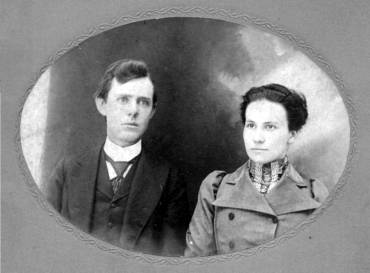


Posted in Associated Families |
Leave a Comment »
June 14, 2010
About two weeks ago I had the pleasure of meeting one of Laura Alta (Davis) Shoptaugh’s grandsons. Laura was an avid genealogist and did extensive research on the Wakefield, Davis, Shoptaugh, and several other associated families (see The Davis and Wakefield Families). Lee, one of her grandsons, has Laura’s original research and many photographs of her and her family.
Lee was kind enough to allow me to bring a small portion of her research home to make copies (see LADS and Laura Alta (Davis) Shoptaugh Wakefield Research in file sharing). I will continue to make copies of her research in the coming weeks while I am working in Phoenix. Correspondence between Laura and Roberta Wakefield (Wakefields of the South), Laura’s Wakefield Research, and a few other items will be posted in the file sharing section.
More information forthcoming when time permits.
Posted in Associated Families |
Leave a Comment »
September 15, 2009
I knew that the Davis and Wakefield families were close but it never really occurred to me how close they could or would be. In the miscellaneous records for Franklin County, Indiana found at the LDS Genealogy Library the following was found:


The Wakefields were living with the Davis family on Market Street in Brookville. The families did not stay here long as they moved to Bartholomew County, Indiana and then to Tennessee. Not surprisingly, the Wakefields and Davis family are found living next door to each other in the 1830 census in Tennessee.
Posted in Associated Families, Indiana, My Direct Line, Wakefield |
Leave a Comment »


































